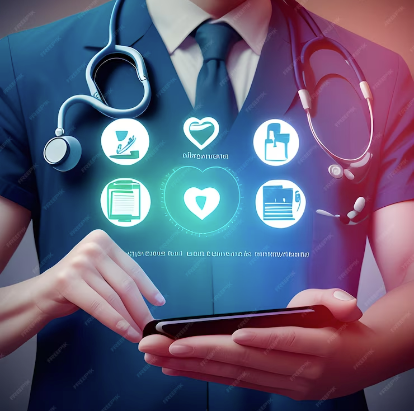In recent years, telehealth has emerged as a transformative force in the healthcare landscape. Driven by advances in technology and accelerated by the COVID-19 pandemic, telehealth tools have redefined how patients interact with their healthcare providers. These tools not only enhance patient convenience but also improve the efficiency and effectiveness of care. Here are five innovative telehealth tools that are making significant impacts on patient care.
1. Virtual Care Platforms
Virtual care platforms have become the cornerstone of modern telehealth. These platforms enable patients to have real-time consultations with healthcare providers through video calls, chat, or phone. Companies like Teladoc, Amwell, and Doxy.me offer robust virtual care solutions that integrate with electronic health records (EHRs) and provide features such as appointment scheduling, secure messaging, and remote monitoring.
Benefits:
- Accessibility: Patients can access care from the comfort of their homes, reducing the need for travel and minimizing exposure to infectious diseases.
- Continuity of Care: Virtual consultations make it easier for patients to follow up on treatments and management plans without delays.
- Cost Efficiency: Reduces the overhead associated with in-person visits and can lower costs for both patients and providers.
2. Remote Patient Monitoring (RPM) Devices
Remote Patient Monitoring (RPM) devices are changing the game by allowing healthcare providers to track patients' health metrics from a distance. Devices like wearable ECG monitors, glucose meters, and blood pressure cuffs collect data that is transmitted to healthcare providers in real-time. Companies such as Fitbit Health Solutions, Withings, and iRhythm Technologies are at the forefront of this innovation.
Benefits:
- Early Detection: Continuous monitoring helps in early detection of health issues, potentially preventing serious complications.
- Personalized Care: Data collected can be used to tailor treatment plans based on individual patient needs and responses.
- Improved Patient Engagement: Patients become more involved in their own health management, leading to better adherence to treatment plans.
3. AI-Powered Diagnostic Tools
Artificial Intelligence (AI) is revolutionizing diagnostics through telehealth by analyzing medical images, symptoms, and patient data more quickly and accurately. Tools such as IBM Watson Health, PathAI, and Zebra Medical Vision use AI algorithms to assist in diagnosing diseases and predicting patient outcomes.
Benefits:
- Enhanced Accuracy: AI can detect patterns and anomalies that might be missed by the human eye, leading to more accurate diagnoses.
- Efficiency: AI tools can process vast amounts of data quickly, speeding up the diagnostic process.
- Decision Support: Provides healthcare providers with additional insights and recommendations, supporting clinical decision-making.
4. Telehealth Chatbots
Telehealth chatbots are an innovative tool designed to provide immediate assistance and information to patients. These AI-driven chatbots can answer health-related questions, offer symptom checking, and even schedule appointments. Companies like Babylon Health and HealthTap have developed sophisticated chatbots that integrate with existing telehealth platforms.
Benefits:
- 24/7 Availability: Chatbots provide round-the-clock access to information and support, improving patient satisfaction and reducing the burden on healthcare staff.
- Symptom Triage: Helps patients determine the urgency of their symptoms and guides them to the appropriate care level.
- Operational Efficiency: Reduces the time healthcare professionals spend on routine inquiries, allowing them to focus on more complex cases.
5. Digital Therapeutics
Digital therapeutics (DTx) are evidence-based therapeutic interventions delivered through software applications. These tools offer treatments for various conditions, from mental health disorders to chronic diseases. Examples include apps like Pear Therapeutics' reSET for substance use disorder and Omada Health's digital program for chronic disease management.
Benefits:
- Evidence-Based: DTx are developed based on clinical research and are often used in conjunction with traditional therapies.
- Accessibility: Provides patients with convenient access to therapeutic interventions, which can be particularly beneficial for those in remote or underserved areas.
- Data-Driven Insights: Collects data on patient progress and adherence, allowing for real-time adjustments to treatment plans.
The Future of Telehealth
As telehealth technology continues to evolve, we can expect even more innovative tools and solutions to emerge. The integration of artificial intelligence, machine learning, and advanced data analytics will likely drive further advancements in telehealth. Moreover, regulatory changes and increased investment in telehealth infrastructure will enhance the accessibility and quality of remote care.
Challenges and Considerations
Despite the many benefits, there are challenges associated with telehealth tools. Issues such as data security, regulatory compliance, and technology adoption barriers must be addressed to fully realize the potential of telehealth. Ensuring that these tools are user-friendly and accessible to all patients, including those with limited digital literacy, is also crucial.
Conclusion
The five telehealth tools highlighted above—virtual care platforms, remote patient monitoring devices, AI-powered diagnostic tools, telehealth chatbots, and digital therapeutics—are at the forefront of transforming patient care. These innovations improve patient access and engagement and enhance healthcare delivery quality and efficiency. As technology advances, telehealth will play an increasingly central role in healthcare's future, offering new opportunities for improving patient outcomes and overall health management.
Embracing these tools and staying informed about the latest developments in telehealth will be essential for both healthcare providers and patients as we navigate the evolving landscape of digital health.
Get in touch for healthcare software development.





Comments